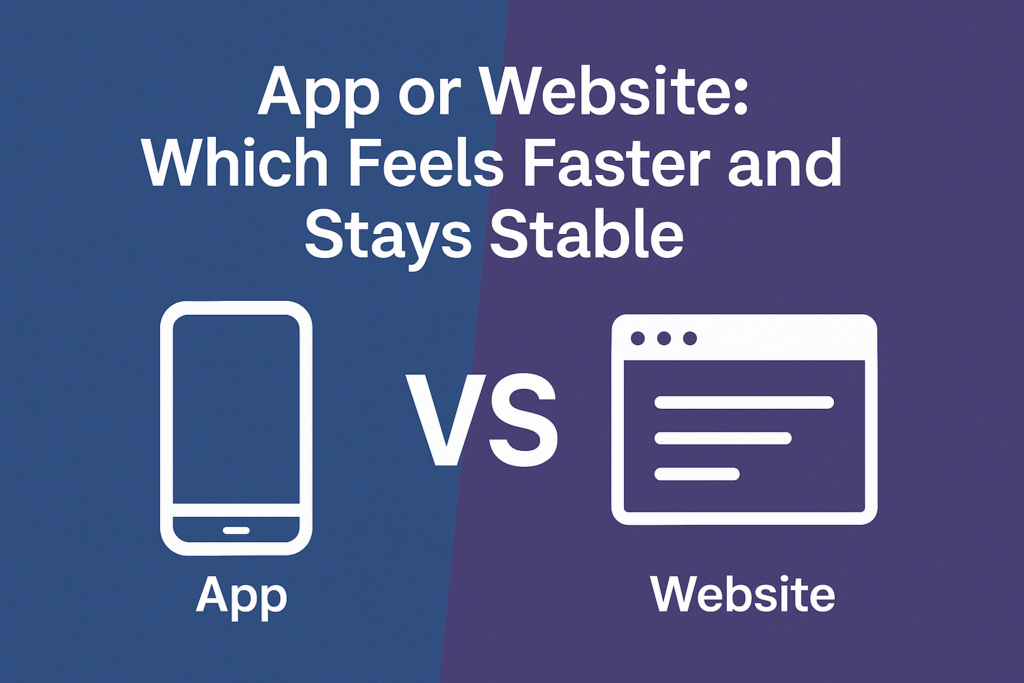Speed and stability decide whether a session feels smooth or heavy. A native app promises tight integration with the device. A well built website promises instant reach with no install. Both can fly or crawl depending on design choices. The only honest answer is to look at how each approach moves data, draws frames, and survives shaky networks.
Real decisions often happen while checking promos and comparing real world flows. While exploring offers at 4rabet the same question appears in practice. Does the installed app open quicker and hold a connection better, or does the browser deliver the same result with fewer steps. The truth hides in caching, render paths, and guardrails against failure.

Contents
Where speed really comes from
A native app can pull assets from local storage and talk to the operating system without extra layers. That removes some overhead and makes touch input feel crisp. A modern website answers with progressive techniques. Service workers cache shells, HTTP compression shrinks payloads, and a content delivery network brings files closer to the device. When both sides do their homework, the gap narrows to milliseconds that only show up under stress.
Perceived speed matters more than raw numbers. A fast first paint with meaningful content calms the eye even if the rest streams in quietly. Skeleton screens and optimistic UI can make a website feel alive while data arrives. An app can misfire if it waits for a full sync before showing anything. The winner is the one that shows intent early and keeps interaction responsive.
Stability in the messy real world
Crashes and stalls break trust quicker than slow loads. Native apps enjoy stronger memory control and background threads, which helps when decoding media or handling many animations. Browsers isolate tabs and sandboxes scripts, so a single misbehaving component is less likely to take down the entire session. Error handling decides outcomes. Clear retries, timeouts, and state recovery will beat raw horsepower every time.
Security also plays into stability. Apps rely on store reviews and signed updates. Websites push fixes instantly and avoid version drift across users. Both can be safe when encryption and permissions are handled with care. Both can fail when logging is weak and edge cases are ignored.
Quick wins for faster loads
- Local first content
Show a cached shell instantly and stream the rest in the background - Tight images and video
Use modern formats with adaptive bitrate to fit current bandwidth - Lean scripts and styles
Remove unused code and split bundles so early screens carry less weight - Prefetch with intent
Predict the next tap and warm the cache without blocking input - Warm authentication
Keep secure tokens fresh so protected pages open without extra prompts
A simple rollout plan turns these wins into habits. Set clear performance budgets for first contentful paint, largest contentful paint, and time to interactive, then track them with real user monitoring on common devices and networks. Ship changes behind feature flags, compare A and B safely, and only promote versions that cut both load time and error rates. Audit third party scripts, fonts, and analytics every month, remove anything that does not earn its cost, and keep service worker caches versioned so stale assets cannot linger. Test on a modest phone over average mobile data before every release so improvements are real in everyday conditions, not only in the lab.
When an app has the edge
An app pulls ahead when a product relies on heavy device features. Low latency sensors, complex touch gestures, and background tasks run best inside native code. Persistent login and push notifications reduce friction in daily use. Offline mode is typically stronger in an app because data layers can sync quietly and respect battery constraints.
Monetization flows can also feel steadier in a native shell. Payment sheets integrate with biometrics and reduce form fatigue. That said, many modern browsers now support the same sheets with fast fallback paths. The difference is smaller than it used to be.
When a website wins the moment
A website shines in reach and freshness. There is no install, no updates, and no storage anxiety. Links share cleanly across chats and open on any platform with consistent behavior. Discovery is easier because search engines index content without asking for a download. For one time visits or light research, the browser is usually the fastest door into a service.
Accessibility is another strong point. Browser tools for contrast, zoom, and screen readers travel with the user across sites. Good semantic markup turns into better experiences without extra work. Apps can match this, yet only when teams invest in parallel efforts for multiple platforms.
What slows everything down
- Blocking splash screens
Long brand screens that delay first interaction and hide network work - Chatty APIs
Many small requests instead of a compact payload that queues sensibly - Overdraw on UI
Layers that repaint unnecessarily and drop frames during scroll - Unbounded caches
Storage that grows without limits and forces thrash when space runs low - Missing fallbacks
Features that fail silently when permissions or sensors are unavailable
A quick recovery plan starts with a baseline on a mid-range phone over average mobile data. Measure time to first interaction and time to first useful action, then fix the worst offender in each category before adding features. Replace blocking screens with progressive content, batch network calls behind a single endpoint, cap caches with clear eviction rules, and wire graceful fallbacks for every permission and sensor. Rerun the same test set weekly so regressions surface early and stability trends stay visible.
Practical way to choose
Test like a curious user rather than a lab. Time the journey from tap to first useful action on a regular phone over average mobile data. Switch between Wi Fi and carrier mid flow. Trigger a lost connection and watch recovery. Repeat on low battery. The better path is the one that keeps the state intact and answers quickly across these bumps.
Final view
There is no universal winner. A disciplined website can feel instantaneous and stable for most tasks. A well built app can deliver a tighter loop and stronger offline resilience. The smartest strategy uses both. Lead with a fast web experience for discovery and casual sessions. Offer an app for frequent use where notifications, offline data, and device features create clear value. With that blend, speed and stability stop being a debate and start being a design habit.



